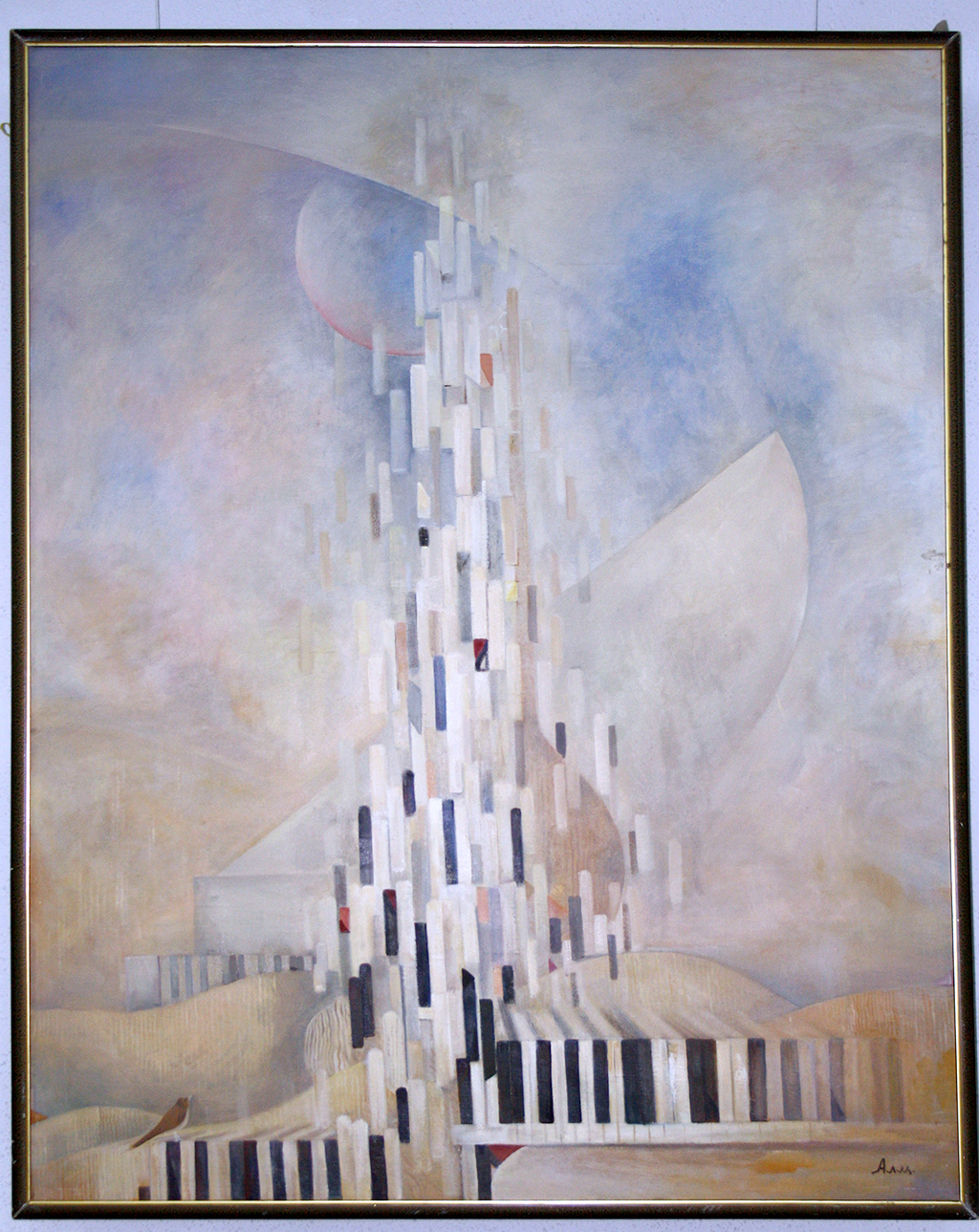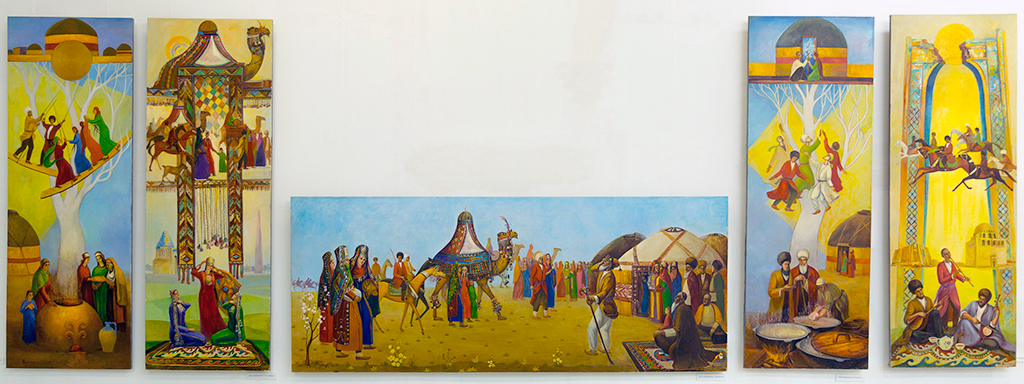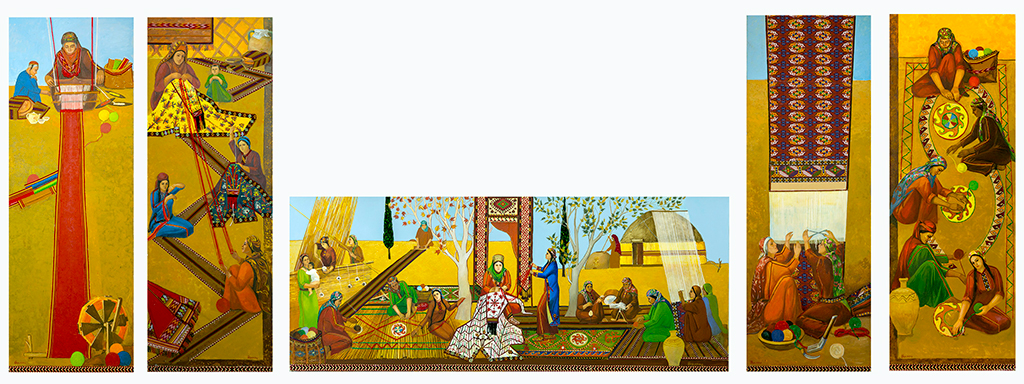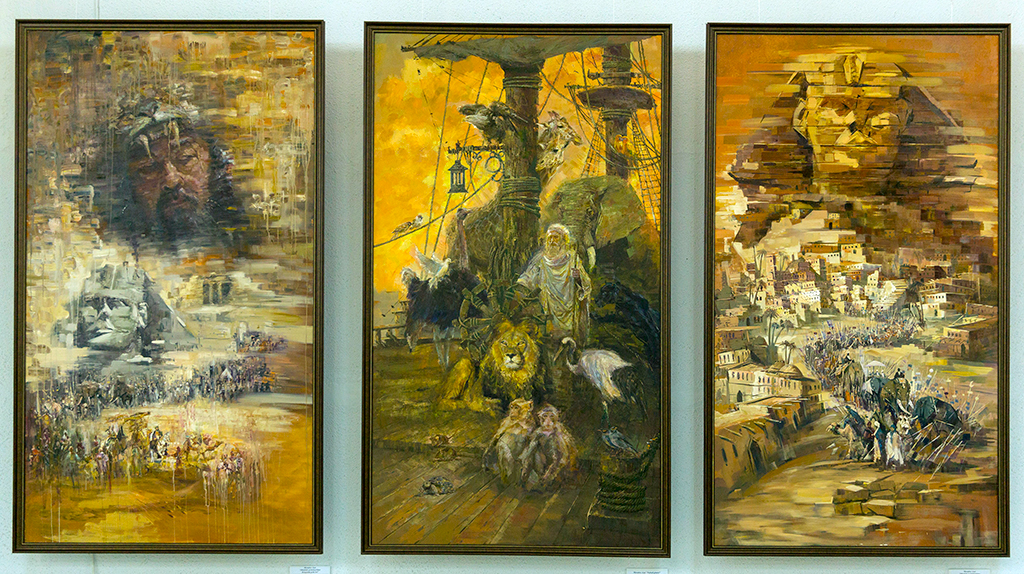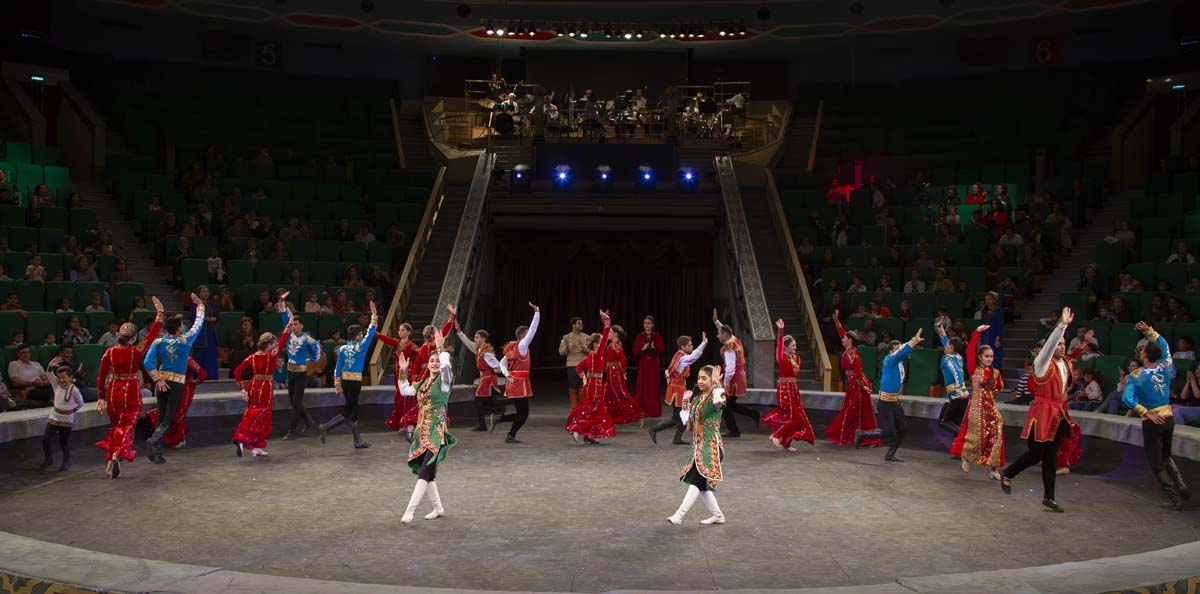This December sees a very special event for professionals and art enthusiasts alike – an exhibition of four painters, whose works have left visitors to an exhibition at the capital’s Expo Center totally amazed, impressed and mesmerized. Students of the Academy of Arts, mentored by the painters, fellow painters and creative professionals – performing artists, writers, journalists – all those who are partial to painting came to visit the exhibition, which aroused great interest, despite the pandemic.
These four painters are People’s Artist of Turkmenistan Annadurdy Almammedov, Honored Artist of Turkmenistan Allamurat Mukhammedov, Azat Muradov and Hojamukhammet Churiev. After the first wave of visitors melted away and there were only individuals either paying a repeat visit or attending the exhibition at the recommendation of their acquaintances, we requested Honored Art Worker of Turkmenistan Azat Annaev that he comment on the unusual exhibition.
– The exhibition is distinctly unusual, indeed, Azat Hudaiberdyevich admitted at once. The four painters, who are of different ages, have different individual styles, different visions and mindsets, had agreed in some way and created these fine works during the year. Notably, they kept their preparations for the exhibition absolutely secret. No one, apart from me (only in the early stages of preparations) was allowed to pay visits to their workrooms. And a year later, the outcomes of their work surpassed all the expectations.
It is no secret that Annadurdy Almammedov is in love with mountains, especially the so-called Lunar Mountains, located not far from his home in Kizil-Arvat (presently Serdar). Throughout his career, he has painted so many mountain landscapes that now there is a joke popular with artists: if somebody wants to paint the Lunar Mountains, they should receive Annadurdy Almammedov’s blessing, otherwise nothing will come out of it.
I was quite overtaken by his triptych “Moonlight Night”. Who could guess that these black and white landscapes were created by someone who is in his eighties! I would expect something like this from a young, bold artist who has come with an original idea of painting the lunar mountains at night. And the two colors convey a laconic, but powerful message. The triptych depicts no moon, just its glow. At first sight, the mountains look the same; however a closer look reveals they are three different landscapes. The light-hued mountains traversed with deep lines - “wrinkles” are associated with the painter’s face. The triptych can allegorically represent the artist’s life and be regarded as a self-portrait. Like a mountain, Almammedov defies his age, is firmly established and has his personal voice in art.
According to the rules specified by the organizers, the exhibition should only feature paintings that would be exhibited for the first time. But an exception was made for Annadurdy Almammedov’s “Tribute to Nury Halmamedov”. The painting depicts a fountain of piano keys shooting upwards. Probably, our composer of genius would have experienced something similar deep down inside when inspiration struck. The painter was able to vividly capture and powerfully convey the feelings in his avant-garde painting.
At first, Annadurdy Almammedov worked as a theater production designer, and many of his sketches for theatrical productions are stored in the storerooms of the Museum of Fine Arts. Later, he worked as a teacher at an art school. He is still now working at the Academy of Arts.
Annadurdy Almammedov is a close associate of the following famous Turkmen artists: Izzat Klychev, Durdy Bayramov, Gulnazar Bekmuradov, Sajan Akmukhammedov, Stanislav Babikov, and Chary Amangeldyev. By the way, he is a mentor of one of the artists participating in the exhibition – Hojamukhammet Churiev.
***
Two colorful pentaptychs by Hojamukhammet Churiev take up the entire length of one of the walls of the exhibition hall. On the left is the painter’s portrayal of a Turkmen wedding. Interestingly, no artists have depicted Turkmen wedding traditions like this before. The pentaptych entitled “Wedding” is composed of five paintings. It portrays a whole array of wedding rites from a marriage proposal to the arrival of the bride perched atop a camel at the groom’s home to a loud announcement of the bride’s arrival by a herald (jarchy), to a traditional welcome with smoldering yüzärlik (Peganum Harmala plant) extended to the bride by her mother-in-law at the yurt, the custom originated from Zoroastrianism. The work can be looked at endlessly: it shows the artist’s great creativity and imagination, and the use of rather unusual techniques. For instance, the vertical paintings feature a light, straight road with people dancing joyfully. Later, the road forks and turns into a tree. The first painting shows a conventional yurt. The yurt in the fourth painting has a white wedding felt cover atop. The newlyweds are sitting at the entrance holding a young fruit tree in their hands as the symbol of happiness and new life. The fifth painting portrays the sun - the symbol of eternity, as if saying: “That is the way it was and will always be!” with bagshys (folk musicians) singing in celebration of it. Nearby in the fourth painting are steaming cauldrons with delicious wedding pilaf. Blue, pink, and yellow, the colors of purity, joy and happiness dominate the pentaptych.
The work should be viewed from all angles, while paying attention to every detail in order to understand the artist’s central idea. Another pentaptych entitled “Turkmen Craftswomen” is devoted to folk crafts, to be more precise, to Turkmen women, weaving the beautiful keteni fabric by hand, embroidering chirpy (a robe worn over the head in a cloak-like fashion), and making felt. Keteni runs in a zigzag line from an older woman to a younger one, representing the continuity of folk art. The women in the pentaptych look majestic. The paintings are reminiscent of frescoes.
Once, I came to Hojamukhammet’s workroom when he was preparing a keteni appliqué nearly two meters high for his painting. I was surprised, and honestly, I doubted that his project would be successful. Futurist artists and Pablo Picasso tended to use appliqués in their paintings. Among Turkmen artists, keteni ribbon appliqués can be seen in paintings by Ishanguly Ishangulyev, and appliqués in the shape of cartridge cases in paintings by Vladimir Bagdasaryan. But with the fabric as a key element in the painting, it was a totally novel approach!
However, when I saw Hojamukhammet’s painting at the exhibition, I shook his hand having nothing but admiration for his imagination and vision. Apart from keteni, Hojamukhammet “clothed” a cypress tree in green velvet, used natural threads in motifs of national embroidery and wedding headscarves.
The works by Hojamukhammet Churiev convincingly demonstrate that the artist is armed with lively and vivid imagination. He has an enviable ability to work diligently and spends most of his time in his workroom. He does not seek inspiration, but draws it in his work. Hojamukhammet came to art late in life. He was born in Kushka. Before he began to study, he was a shepherd. According to him, he borrowed books from the rural library and read them astride his donkey, looking after a flock of sheep. This did not prevent him from passing entrance examinations successfully at the State Academy of Arts (which had just been founded then) and becoming one of its first alumni. Among his creatively gifted fellow students were Bayram Nuriev, Akhat Nuvvaev, Mukhammet Babaev, and others. Those who graduated from the Academy in 2000 were dubbed mentees of Gulnazar Bekmuradov, the founder of the Academy.
***
After the colorful and vivid paintings by Hojamukhammet Churiev, Azat Muradov’s Realist triptych in gray and brown hues heightens the contrast. But, once viewers take a closer look at it, they are immediately captivated by the dramatic nature. The triptych’s subject matter is Noah and the Ark. According to the Bible, God told Noah he had to build an ark in preparation for the great flood, and as instructed by God he took into the ark male and female specimens of every animal to preserve life. Every single muscle in his face seems incredibly tense while he carries out this important mission. However, he carries it off well and manages to stay calm in the ark. The birds and animals behave in the same manner. This psychological drama can be distinctly perceived by viewers.
To the left of Noah, a painting entitled “Better a Beggar in Kendan than a Sultan in Egypt”. The painting takes viewers back in time to the 13th century. Bulat Mansurov has directed a film called “Sultan Baybars”. Our countryman Baybars was taken captive by Arabs and sold as a slave. As he was a heavily-built man, he became a Mamluk - a slave soldier (from Arabic mamluk literally “slave). Egyptian upper classes tended to strongly rely on brave and reckless Mamluks. Taking advantage of this, Mamluks rose in rebellion and Baybars came to power. He ruled Egypt for a long time, but the ruler felt desperately homesick for his native land. Once when he was an old man, he disappeared… He was neither killed nor died from a disease. No one knows what happened to him; supposedly he left the Palace to go back to his homeland…
Azat Muradov’s painting portrays Sultan Baybars as a courageous and brave man but with a touch of overwhelming sadness on his face amid the hectic and busy Egyptian life of the day.
Painted in the same gray and brown hues, Azat’s painting depicts an extract from the folk epic “Gerogly”, telling the story of a little boy living in the graveyard and surviving on goat’s milk, who finds himself among people at last.
Azat is a highly versatile painter, who works in different media. He has painted wonderful lyrical portraits (especially those of children) and beautiful landscapes. But he has excelled at depicting large battle scenes with every single soldier having a distinctive personality.
***
On display are the works by the fourth painter, Allamurat Mukhammedov. He presents a painting entitled “Novruz”. Allamurat brilliantly enciphers his ideas in his Surrealist and Symbolist paintings. He wants his viewers to find the clue themselves. Above his paintings “Novruz” and “Mirages of Dekhistan”, the exhibition features a series of his Realist paintings devoted to ancient military leaders. However, the painter regards Realist portrayals of ancient legends as well as of traditional celebrations as fairly trivial.
That is why in his painting “Novruz” all the characters are closely entwined. Everything in the painting is on the same wave. And the wave for the artist is the swift passage of time. Allamurat does not depict clusters of twinkling stars, but realistic-looking animals with a Bull and a Lion floating across the night sky. At the same time, he achieves harmony in color, like a composer composing music for different instruments brings them together in the same symphony.
“Mirages of Dekhistan” is devoted to Ancient Dekhistan Cultural and Historical Park located in Balkan Velayat. The surviving structures of the Main Mosque destroyed by the army of Genghis Khan serve as a reminder of its former grandeur with 20-meter-high minarets partly destroyed. It is depicted with the use of Surrealist techniques and a gold fabric appliqué. In the center the painting portrays a man and a woman carefully guarding the national wealth. In his encrypted manner, the artist depicts a stylized horse and figures of a man, woman and a child on horseback. They are reminiscent of chess pieces. It is no coincidence as ancestors of the great medieval chess player Muhammet as-Suli lived in those places. Our compatriot won a chess tournament in Bagdad. Ylkham (Inspiration) Alley features a bronze statue of the chess player in commemoration of the glorious occasion.
The exhibition of the works by the four artists has given a big and special treat to professionals and art lovers they are unlikely to forget. Each of them has his unique style, color palette and distinctive characters. Although the exhibited works are richly diverse, they are closely united by the artists’ love for their native country, its nature and history, folk customs and great sons of Turkmen land. The exhibition conveys a patriotic and life-affirming message.
These four painters are People’s Artist of Turkmenistan Annadurdy Almammedov, Honored Artist of Turkmenistan Allamurat Mukhammedov, Azat Muradov and Hojamukhammet Churiev. After the first wave of visitors melted away and there were only individuals either paying a repeat visit or attending the exhibition at the recommendation of their acquaintances, we requested Honored Art Worker of Turkmenistan Azat Annaev that he comment on the unusual exhibition.
– The exhibition is distinctly unusual, indeed, Azat Hudaiberdyevich admitted at once. The four painters, who are of different ages, have different individual styles, different visions and mindsets, had agreed in some way and created these fine works during the year. Notably, they kept their preparations for the exhibition absolutely secret. No one, apart from me (only in the early stages of preparations) was allowed to pay visits to their workrooms. And a year later, the outcomes of their work surpassed all the expectations.
It is no secret that Annadurdy Almammedov is in love with mountains, especially the so-called Lunar Mountains, located not far from his home in Kizil-Arvat (presently Serdar). Throughout his career, he has painted so many mountain landscapes that now there is a joke popular with artists: if somebody wants to paint the Lunar Mountains, they should receive Annadurdy Almammedov’s blessing, otherwise nothing will come out of it.
I was quite overtaken by his triptych “Moonlight Night”. Who could guess that these black and white landscapes were created by someone who is in his eighties! I would expect something like this from a young, bold artist who has come with an original idea of painting the lunar mountains at night. And the two colors convey a laconic, but powerful message. The triptych depicts no moon, just its glow. At first sight, the mountains look the same; however a closer look reveals they are three different landscapes. The light-hued mountains traversed with deep lines - “wrinkles” are associated with the painter’s face. The triptych can allegorically represent the artist’s life and be regarded as a self-portrait. Like a mountain, Almammedov defies his age, is firmly established and has his personal voice in art.
According to the rules specified by the organizers, the exhibition should only feature paintings that would be exhibited for the first time. But an exception was made for Annadurdy Almammedov’s “Tribute to Nury Halmamedov”. The painting depicts a fountain of piano keys shooting upwards. Probably, our composer of genius would have experienced something similar deep down inside when inspiration struck. The painter was able to vividly capture and powerfully convey the feelings in his avant-garde painting.
At first, Annadurdy Almammedov worked as a theater production designer, and many of his sketches for theatrical productions are stored in the storerooms of the Museum of Fine Arts. Later, he worked as a teacher at an art school. He is still now working at the Academy of Arts.
Annadurdy Almammedov is a close associate of the following famous Turkmen artists: Izzat Klychev, Durdy Bayramov, Gulnazar Bekmuradov, Sajan Akmukhammedov, Stanislav Babikov, and Chary Amangeldyev. By the way, he is a mentor of one of the artists participating in the exhibition – Hojamukhammet Churiev.
Two colorful pentaptychs by Hojamukhammet Churiev take up the entire length of one of the walls of the exhibition hall. On the left is the painter’s portrayal of a Turkmen wedding. Interestingly, no artists have depicted Turkmen wedding traditions like this before. The pentaptych entitled “Wedding” is composed of five paintings. It portrays a whole array of wedding rites from a marriage proposal to the arrival of the bride perched atop a camel at the groom’s home to a loud announcement of the bride’s arrival by a herald (jarchy), to a traditional welcome with smoldering yüzärlik (Peganum Harmala plant) extended to the bride by her mother-in-law at the yurt, the custom originated from Zoroastrianism. The work can be looked at endlessly: it shows the artist’s great creativity and imagination, and the use of rather unusual techniques. For instance, the vertical paintings feature a light, straight road with people dancing joyfully. Later, the road forks and turns into a tree. The first painting shows a conventional yurt. The yurt in the fourth painting has a white wedding felt cover atop. The newlyweds are sitting at the entrance holding a young fruit tree in their hands as the symbol of happiness and new life. The fifth painting portrays the sun - the symbol of eternity, as if saying: “That is the way it was and will always be!” with bagshys (folk musicians) singing in celebration of it. Nearby in the fourth painting are steaming cauldrons with delicious wedding pilaf. Blue, pink, and yellow, the colors of purity, joy and happiness dominate the pentaptych.
The work should be viewed from all angles, while paying attention to every detail in order to understand the artist’s central idea. Another pentaptych entitled “Turkmen Craftswomen” is devoted to folk crafts, to be more precise, to Turkmen women, weaving the beautiful keteni fabric by hand, embroidering chirpy (a robe worn over the head in a cloak-like fashion), and making felt. Keteni runs in a zigzag line from an older woman to a younger one, representing the continuity of folk art. The women in the pentaptych look majestic. The paintings are reminiscent of frescoes.
Once, I came to Hojamukhammet’s workroom when he was preparing a keteni appliqué nearly two meters high for his painting. I was surprised, and honestly, I doubted that his project would be successful. Futurist artists and Pablo Picasso tended to use appliqués in their paintings. Among Turkmen artists, keteni ribbon appliqués can be seen in paintings by Ishanguly Ishangulyev, and appliqués in the shape of cartridge cases in paintings by Vladimir Bagdasaryan. But with the fabric as a key element in the painting, it was a totally novel approach!
However, when I saw Hojamukhammet’s painting at the exhibition, I shook his hand having nothing but admiration for his imagination and vision. Apart from keteni, Hojamukhammet “clothed” a cypress tree in green velvet, used natural threads in motifs of national embroidery and wedding headscarves.
The works by Hojamukhammet Churiev convincingly demonstrate that the artist is armed with lively and vivid imagination. He has an enviable ability to work diligently and spends most of his time in his workroom. He does not seek inspiration, but draws it in his work. Hojamukhammet came to art late in life. He was born in Kushka. Before he began to study, he was a shepherd. According to him, he borrowed books from the rural library and read them astride his donkey, looking after a flock of sheep. This did not prevent him from passing entrance examinations successfully at the State Academy of Arts (which had just been founded then) and becoming one of its first alumni. Among his creatively gifted fellow students were Bayram Nuriev, Akhat Nuvvaev, Mukhammet Babaev, and others. Those who graduated from the Academy in 2000 were dubbed mentees of Gulnazar Bekmuradov, the founder of the Academy.
After the colorful and vivid paintings by Hojamukhammet Churiev, Azat Muradov’s Realist triptych in gray and brown hues heightens the contrast. But, once viewers take a closer look at it, they are immediately captivated by the dramatic nature. The triptych’s subject matter is Noah and the Ark. According to the Bible, God told Noah he had to build an ark in preparation for the great flood, and as instructed by God he took into the ark male and female specimens of every animal to preserve life. Every single muscle in his face seems incredibly tense while he carries out this important mission. However, he carries it off well and manages to stay calm in the ark. The birds and animals behave in the same manner. This psychological drama can be distinctly perceived by viewers.
To the left of Noah, a painting entitled “Better a Beggar in Kendan than a Sultan in Egypt”. The painting takes viewers back in time to the 13th century. Bulat Mansurov has directed a film called “Sultan Baybars”. Our countryman Baybars was taken captive by Arabs and sold as a slave. As he was a heavily-built man, he became a Mamluk - a slave soldier (from Arabic mamluk literally “slave). Egyptian upper classes tended to strongly rely on brave and reckless Mamluks. Taking advantage of this, Mamluks rose in rebellion and Baybars came to power. He ruled Egypt for a long time, but the ruler felt desperately homesick for his native land. Once when he was an old man, he disappeared… He was neither killed nor died from a disease. No one knows what happened to him; supposedly he left the Palace to go back to his homeland…
Azat Muradov’s painting portrays Sultan Baybars as a courageous and brave man but with a touch of overwhelming sadness on his face amid the hectic and busy Egyptian life of the day.
Painted in the same gray and brown hues, Azat’s painting depicts an extract from the folk epic “Gerogly”, telling the story of a little boy living in the graveyard and surviving on goat’s milk, who finds himself among people at last.
Azat is a highly versatile painter, who works in different media. He has painted wonderful lyrical portraits (especially those of children) and beautiful landscapes. But he has excelled at depicting large battle scenes with every single soldier having a distinctive personality.
On display are the works by the fourth painter, Allamurat Mukhammedov. He presents a painting entitled “Novruz”. Allamurat brilliantly enciphers his ideas in his Surrealist and Symbolist paintings. He wants his viewers to find the clue themselves. Above his paintings “Novruz” and “Mirages of Dekhistan”, the exhibition features a series of his Realist paintings devoted to ancient military leaders. However, the painter regards Realist portrayals of ancient legends as well as of traditional celebrations as fairly trivial.
That is why in his painting “Novruz” all the characters are closely entwined. Everything in the painting is on the same wave. And the wave for the artist is the swift passage of time. Allamurat does not depict clusters of twinkling stars, but realistic-looking animals with a Bull and a Lion floating across the night sky. At the same time, he achieves harmony in color, like a composer composing music for different instruments brings them together in the same symphony.
“Mirages of Dekhistan” is devoted to Ancient Dekhistan Cultural and Historical Park located in Balkan Velayat. The surviving structures of the Main Mosque destroyed by the army of Genghis Khan serve as a reminder of its former grandeur with 20-meter-high minarets partly destroyed. It is depicted with the use of Surrealist techniques and a gold fabric appliqué. In the center the painting portrays a man and a woman carefully guarding the national wealth. In his encrypted manner, the artist depicts a stylized horse and figures of a man, woman and a child on horseback. They are reminiscent of chess pieces. It is no coincidence as ancestors of the great medieval chess player Muhammet as-Suli lived in those places. Our compatriot won a chess tournament in Bagdad. Ylkham (Inspiration) Alley features a bronze statue of the chess player in commemoration of the glorious occasion.
The exhibition of the works by the four artists has given a big and special treat to professionals and art lovers they are unlikely to forget. Each of them has his unique style, color palette and distinctive characters. Although the exhibited works are richly diverse, they are closely united by the artists’ love for their native country, its nature and history, folk customs and great sons of Turkmen land. The exhibition conveys a patriotic and life-affirming message.




